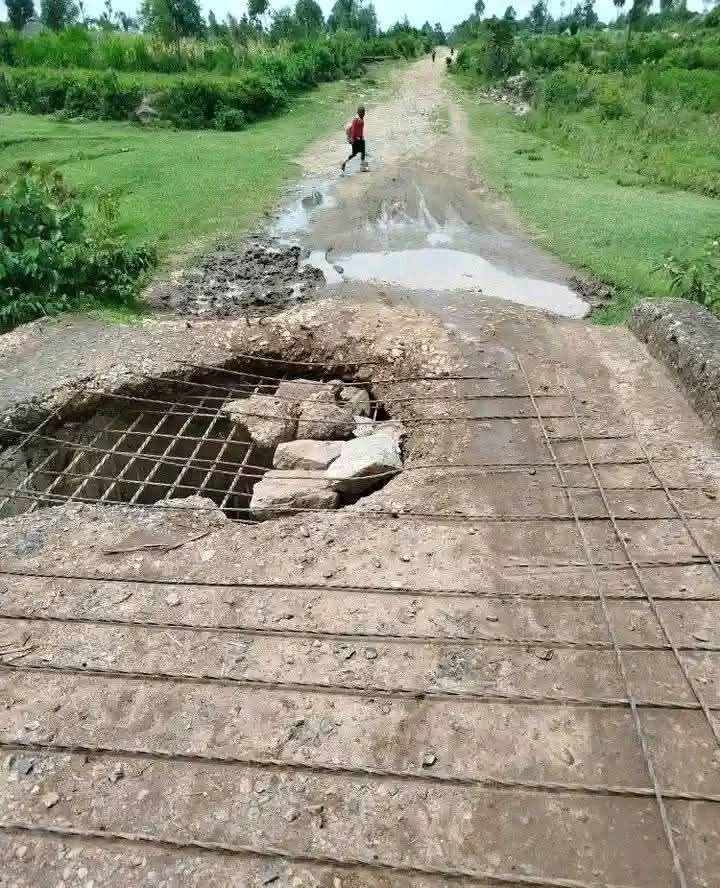A Vital Link Now in Peril
In the serene hills of Kipreres, Bomet County, a small bridge has quietly turned into a symbol of neglect. For decades, it connected families, students, and farmers to essential services. Today, locals describe it as “dangerous beyond imagination,” especially during the rainy season when the swollen river threatens anyone attempting to cross. This isn’t just a story about infrastructure — it’s about public safety, economic livelihoods, and government accountability.
The bridge once facilitated daily life, enabling farmers to transport their produce to local markets, children to attend school safely, and patients to reach nearby clinics. Its deterioration, however, reflects a wider pattern of rural infrastructure neglect, raising questions about equitable development and community resilience.
The Human Cost: More Than a Structure
While images of a broken bridge might seem trivial to policymakers, for the Kipreres community, every crossing is a potential hazard. Parents carry children on precarious makeshift walkways, students risk injury daily, and local traders face losses as they struggle to move goods. Anecdotes from residents highlight near-tragic incidents, including accidents during floods and injuries from crumbling planks.
The emotional impact is profound. Fear and anxiety accompany daily life, while frustration grows due to repeated unfulfilled promises from authorities. One local elder lamented, “We have petitioned, pleaded, and even demonstrated, yet no one comes to repair our bridge. Our children’s safety is at stake.”
Economic Implications: Small Livelihoods, Big Losses
Infrastructure neglect doesn’t just compromise safety — it hinders economic activity. Farmers transporting crops, particularly perishable goods like tomatoes, potatoes, and maize, face delays that can lead to spoilage and financial loss. Small traders and boda boda riders either avoid using the bridge entirely or take longer, riskier detours, impacting earnings.
This economic disruption also affects schools and healthcare. Students may miss lessons, and patients are delayed in reaching medical facilities. In emergencies, every minute counts, and a damaged bridge can literally be a matter of life and death.
Why the Government Must Act: Policy and Accountability
The Kipreres bridge represents a test case for rural infrastructure policy in Kenya. It exposes the gap between government promises and on-the-ground realities. Rural development plans often prioritize roads and urban centers, leaving small but critical structures like this bridge overlooked.
Local advocacy groups suggest that a multi-pronged approach is needed:
1. Immediate Safety Measures: Temporary supports and signage to prevent accidents.
2. Long-Term Repairs: Reinforcement with durable materials to ensure resilience against flooding.
3. Community Engagement: Include residents in monitoring and maintenance to prevent future deterioration.
Such action not only restores safety but demonstrates government accountability, building trust between citizens and officials.
Lessons for Other Rural Communities
The situation in Kipreres is not unique. Across Kenya, rural areas face similar infrastructure challenges. What sets Kipreres apart is the community’s proactive approach. Their petitions, social media campaigns, and public appeals illustrate how citizen engagement can amplify local issues. Other communities could emulate this approach to attract attention and resources.
The Role of Media and Public Awareness
Local and national media play a crucial role in highlighting infrastructure neglect. Reporting on the Kipreres bridge has sparked discussion on social media platforms, creating public pressure for action. Awareness campaigns that combine visual evidence, resident testimonials, and data on accidents or economic loss are more likely to spur government intervention.
Personal Commentary: Infrastructure Equals Opportunity
Bridges like the one in Kipreres are more than concrete and steel — they are lifelines. Investing in rural infrastructure is not merely a cost but a catalyst for opportunity. A functional bridge ensures children can attend school, farmers can sell their produce, and health emergencies are addressed promptly. Ignoring such assets perpetuates inequality, slows economic growth, and risks human life.
Recommended Actions for Policymakers
- Audit Vulnerable Bridges: Conduct assessments of all rural bridges to identify risks.
- Prioritize Safety: Implement emergency measures like temporary walkways, warning signs, and local oversight committees.
- Invest in Maintenance: Allocate funds not only for construction but also for regular inspections and repairs.
- Engage Communities: Create platforms for residents to report issues and participate in upkeep.
Such measures turn a neglected bridge into a model for proactive, inclusive rural infrastructure management.
Conclusion: A Call to Responsibility
The forgotten bridge in Kipreres, Bomet, is a stark reminder that infrastructure neglect has immediate human consequences. Beyond the physical dangers, it undermines education, livelihoods, and trust in government. By acting swiftly and responsibly, authorities can restore safety, enable economic activity, and show that the lives of rural citizens are valued equally. For the residents of Kipreres, every repaired plank represents not just a crossing but hope, security, and opportunity.



Reader Responses (0)